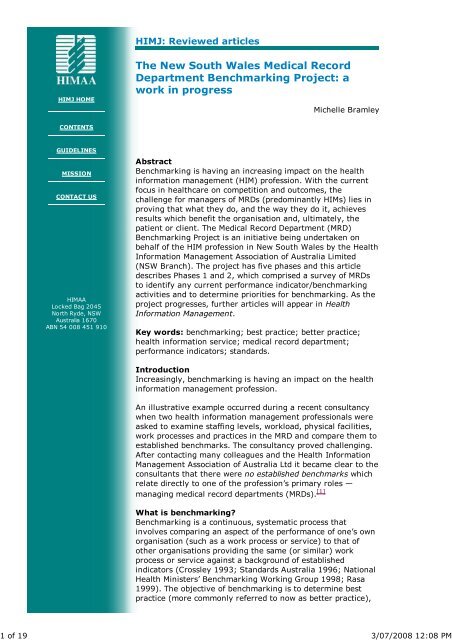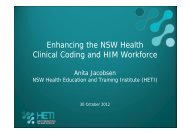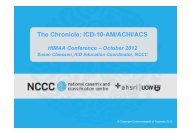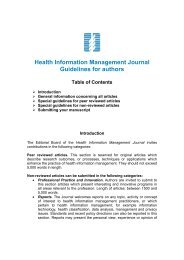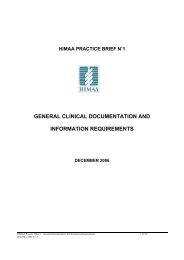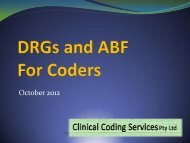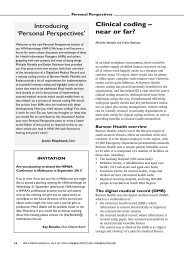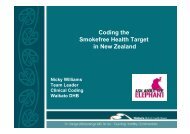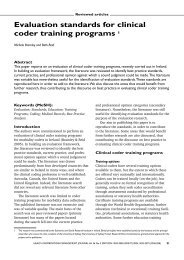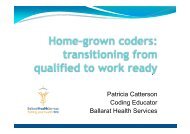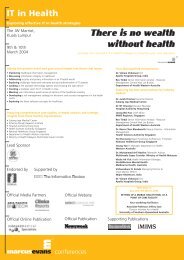NSW MRD Benchmarking - Health Information Management ...
NSW MRD Benchmarking - Health Information Management ...
NSW MRD Benchmarking - Health Information Management ...
You also want an ePaper? Increase the reach of your titles
YUMPU automatically turns print PDFs into web optimized ePapers that Google loves.
of 193/07/2008 12:08 PMIt is easy to understand why the profession is notbenchmarking. <strong>Benchmarking</strong> can only be performed against abackground of established indicators and none have beendeveloped for services provided by <strong>MRD</strong>s.Clearly, before benchmarking initiatives can be undertaken bymanagers of <strong>MRD</strong>s, standardised performance indicatorsreflective of the key processes or services performed by <strong>MRD</strong>smust be developed and established. As the predominant groupof professionals who manage <strong>MRD</strong>s, health informationmanagers must drive the development of these indicators.<strong>Benchmarking</strong> initiatives undertaken by HIMAA Ltd(<strong>NSW</strong> Branch)<strong>Benchmarking</strong> ForumIn August 1997, a Forum was convened at the request ofmembers of HIMAA Ltd (<strong>NSW</strong> Branch) to discuss issuesassociated with performance indicators and benchmarking ofactivities within the profession. Forty-six members participatedand the Forum was considered a successful professionaldevelopment event.The objectives of the Forum were to determine:should the profession benchmark?what should the profession benchmark?how should the profession benchmark?Should the profession benchmark?Members at the Forum recommended that the profession in<strong>NSW</strong> should benchmark. They supported benchmarking as avaluable quality tool, complementing existing qualityimprovement programs. It was considered that theestablishment of standardised performance indicators wouldenable comparison among <strong>MRD</strong>s and the benchmarkingprocess could be used to determine better work practices.How should the profession benchmark?It was recommended that a working party be convened withinHIMAA Ltd (<strong>NSW</strong> Branch) to undertake a project to defineperformance indicators and benchmarking processes for workpractices in <strong>MRD</strong>s. It was agreed that membershiprepresentative of the public and private sectors was needed onthe working party.What should the profession benchmark?Members agreed that five core processes would represent up to80 percent of <strong>MRD</strong>s’ workload. Therefore, it was resolved thatinitial work should focus on five core, generic processes orservices of the <strong>MRD</strong> applicable to public and private hospitals,regardless of size or structure.It was decided that casemix and coding activities be excludedfrom the project on the basis that other parties are conductingbenchmarking initiatives on these activities. For example, the<strong>NSW</strong> <strong>Health</strong> Department compares services provided by <strong>NSW</strong>public hospitals using casemix measures, the National Centrefor Classification in <strong>Health</strong> collects benchmarking informationvia the Australian Coding Benchmark Audit, and HIMAA hasdeveloped clinical coder competencies.
4 of 19 3/07/2008 12:08 PMMedical Record Department <strong>Benchmarking</strong> WorkingPartyHIMAA Ltd (<strong>NSW</strong> Branch) convened the Medical RecordDepartment (<strong>MRD</strong>) <strong>Benchmarking</strong> Working Party (the ‘workingparty’) in February 1998. The core objective of the workingparty is to develop benchmarks for generic processes orservices of <strong>MRD</strong>s in <strong>NSW</strong> that are applicable to public andprivate hospitals, regardless of size or structure.MembershipExpressions of interest to join the working party were soughtfrom HIMAA members at the Forum and a notice was placed inthe Branch newsletter. Seven members responded and formedthe initial working party. Subsequent nominations led to fivenew members joining in March 1999, an encouraging sign thatthe project is generating interest and active participationamong the profession.Members of the working party are listed in Box 1. All haveworked in, managed, or are currently managing <strong>MRD</strong>s. Allmembers have agreed to treat confidentially all informationabout individual departments obtained during the course ofthis project.1: Membership of the HIMAA Ltd (<strong>NSW</strong> Branch) <strong>MRD</strong> <strong>Benchmarking</strong>Working Party (March 2000)Robyn BallisMichelle BramleyGabrielle ChallisWynne ChiuMargaret CookKatarina JurcevicRhonda KealyRose LivolsiGay LysenkoMerrilyn MorrisRobyn SheridanMargaret DumaresqCooma <strong>Health</strong> ServiceNational Centre for Classification in <strong>Health</strong> (Convenor)St Vincent’s Private HospitalSt George HospitalHIM ConsultantBlacktown/Mt Druitt HospitalsNIB <strong>Health</strong> FundsMacarthur <strong>Health</strong> ServiceHIM ConsultantNational Centre for Classification in <strong>Health</strong>Parkes <strong>Health</strong> Service<strong>Health</strong> <strong>Information</strong> Manager (CodeRight)Terms of reference / project planRecommendations from the <strong>Benchmarking</strong> Forum werereworked into terms of reference for the working party. Theterms of reference provided the basis for five phases of theproject plan (see Box 2). The project’s timelines are generousand have been revised periodically to account for the variouscommitments of working party members, as all work isconducted on a voluntary basis.Phases 1 and 2 of the project were completed in April 2000and are outlined in this article.2: Phases of the <strong>MRD</strong> benchmarking projectPhase oneObjective:Develop a questionnaire to survey <strong>MRD</strong>s to determine performanceindicator/benchmarking activitiesTime frame: June 1998 to January 1999Phase two
of 193/07/2008 12:08 PMObjectives:1. Conduct survey to determine five key <strong>MRD</strong> activities tobenchmark2. Collect, collate and analyse data from questionnaireTime frame: January 1999 to December 1999Phase threeObjective:Design prospective pilot study to collect baseline dataTime frame: Activity 1: January 2000 to June 2000Activities 2-5: To be determinedPhase fourObjectives:1. Conduct pilot study to collect baseline data on five key activitiesfor <strong>MRD</strong>s2. Collect, collate and analyse data from pilot studyTime frame: Activity 1: June 2000 to November 2000Activities 2-5: To be determinedNote: Phases 3 and 4 are reiterative — baseline data will be collected sequentiallyon each of the five key <strong>MRD</strong> activities. The dates listed are indicative of datacollection and analysis for only one activity.Phase fiveObjective:Time frame:Prepare final report for HIMAA Ltd (<strong>NSW</strong> Branch) ExecutiveCommittee and <strong>NSW</strong> membersTo be determinedMeetings / tasksApart from an initial face-to-face meeting and brainstormingsession, the tasks of the working party have been centrallyco-ordinated by the Convenor and distributed to members toaction, using the postal service and occasionally e-mail. Thework completed by working party members and responsesmade to the tasks have been centrally collated and thenredistributed for comment.This approach has ensured that rural members are affordedthe opportunity to participate in the project. The otheradvantages have been:no time is lost travellingcost is minimal, essentially involving only postage andprintingwork is more evenly distributed amongst membersskills are strengthened, particularly time managementand written communicationmembers can plan and structure workloads in line withcommitments.Identified disadvantages are:lack of face-to-face interaction amongst membersincreased workload for the Convenorno forum for open discussion or brainstorming: it ischallenging to formulate ideas on paper.The role of Convenor is crucial to the working party’s success.It is important to ensure that each member of the workingparty is aware of the tasks that other members are working onand they each have the opportunity to comment on any issueas the project evolves. Maintaining a team spirit and keepingthe level of enthusiasm high are ongoing challenges for allmembers of the working party.As each phase of the project ends and a new phase begins,planning is essential and it is anticipated that it will be
of 193/07/2008 12:08 PMnecessary to conduct face-to-face meetings. Face-to-facemeetings are also beneficial for both the Convenor andmembers to personally relate to one another and reinforce theteam philosophy.Literature reviewThe sheer volume of literature on benchmarking indicates itsimportance and widespread application. The Commonwealth,State and Territory Governments and Standards Australiahave published benchmarking guidelines and standards.Although most benchmarking literature originates from thebusiness sector, it is interesting to see the growing volume ofbenchmarking literature emerging from the healthcare sector.Concentrating on benchmarking literature related to the HIMprofession narrowed the search.In addition to the HIM-specific literature cited previously, thebenchmarking literature of particular interest to the workingparty were:various Commonwealth initiatives on benchmarking inthe healthcare sector:National Hospital Outcomes Program (clinical indicators)National <strong>Health</strong> Ministers’ <strong>Benchmarking</strong> Working Group(health sector performance indicators addressing equity,productivity and efficiency)National Goals and Targets for Better <strong>Health</strong> (healthstatus indicators)two publications by the <strong>NSW</strong> <strong>Health</strong> Department (1997a,1998) outlining better practice guidelines for theadmission and discharge of patients for electiveprocedures and frontline complaints handling providedfuel for the imagination of members of the working partyJournal of the American <strong>Health</strong> <strong>Information</strong> <strong>Management</strong>Association, 69(10) (1998) focused on benchmarking andbest practice.It appears that the Australian health information managementprofession is not too far behind its American counterparts. Asearch of previous issues of JAHIMA revealed only one articleon benchmarking prior to 1998. The November-December1998 issue of JAHIMA also launched the AHIMA Best PracticesAward Program, in which cash awards are given to AHIMAmembers demonstrating best practice in the field of healthinformation management. Award winners are recognised atAHIMA’s national convention and featured in JAHIMA.Networking is often promoted as a valuable tool for HIMs andso it is not surprising that the most relevant piece of literatureto this project was discovered through networking. Perry’s(1996) unpublished research thesis on the use of performancemeasures in Victorian health information services wassubmitted as a requirement for the award of Bachelor of<strong>Health</strong> <strong>Information</strong> <strong>Management</strong> (Honours) at La TrobeUniversity. Surveying Victorian health information serviceswith 100 or more acute hospital beds, Perry identified whichactivities were being measured in terms of output (workloadstatistics) or performance. Perry also identified the activitiesthat Victorian HIMs believed would benefit most from the useof performance measures.
7 of 19 3/07/2008 12:08 PMAlthough Perry’s research was limited by a low response rate,this significant piece of work provided the working party with asurvey instrument that was adapted for this project.<strong>MRD</strong> benchmarking project — Phase I: development ofsurvey instrumentThe objective of Phase I was development of a questionnaire tosurvey <strong>MRD</strong>s to determine performanceindicators/benchmarking activities.Survey aimsThe four aims of the survey aligned with the working party’sterms of reference:1. To collect demographic data on each <strong>MRD</strong> surveyed2. To ascertain what performance measures and workloadstatistics are currently collected by <strong>MRD</strong>s3. To identify the five activities which <strong>MRD</strong> managersconsider the most important to benchmark4. To recruit participants for future phases to developbaseline benchmarking data for the five selected <strong>MRD</strong>activities.Survey instrumentA comprehensive three-part questionnaire was developed bythe working party. An instruction sheet containing definitionsand an explanation of the project accompanied thequestionnaire.For the purposes of data management and follow-up, thehospital name and hospital identification number identifiedeach questionnaire. The hospital’s identification number asused by the <strong>NSW</strong> <strong>Health</strong> Department was used for the survey.It was emphasised throughout the questionnaire andaccompanying documents that individual hospitals would notbe identified in results.The person responsible for the overall management of the <strong>MRD</strong>was asked to complete the questionnaire.Part I — performance measuresThe 72 performance measures or workload statistics listed inPerry’s (1996) survey instrument provided the basis of thequestionnaire. After refinements and additions, 127performance measures or workload statistics which a <strong>MRD</strong> maycollect were listed in a table format and grouped under mainactivity headings that would be common to most <strong>MRD</strong>s:record filing, tracking, culling and destructionrequests for patient information (Freedom of <strong>Information</strong>- FoI)requests for patient information (medico-legal requests)requests for patient information (other than FoI andmedico-legal requests)investigation reports/correspondence filing (loose sheets)record retrieval (other than for medico-legal requests)medical transcriptionstatistics and associated proceduresforms controldata collections
8 of 19 3/07/2008 12:08 PMdischarge compilation of medical record.Respondents were asked to tick one of three boxes (collected,not collected or not applicable) for each performance measureor workload statistic listed. Respondents were also given theoption to add performance measures or statistics, which werenot listed in the questionnaire.The distinction between ‘not collected’ and ‘not applicable’required particular emphasis in the questionnaire andaccompanying instructions. Perry (1996) had highlighteddifficulties in her study with the interpretation of survey data,particularly being unable to establish whether activities werenot performed by an <strong>MRD</strong> (that is, ‘not applicable’) or that datarelating to the activities was not collected by that <strong>MRD</strong>. It wascrucial to this project to identify the activities performed byeach <strong>MRD</strong> and ascertain whether they collected performancedata on each of these activities.Part II — priorities for benchmarkingTo assist respondents in defining their priorities forbenchmarking, the working party drew on Balding’s (1995)work and asked respondents to first ask themselves keyquestions:1. Why do <strong>MRD</strong>s exist?2. Which services performed have the greatest impact onpatients and their care?3. Which other services of major importance to theorganisation does the <strong>MRD</strong> provide?Respondents were asked to consider the characteristics ofprincipal functions when identifying the five most importantmain activities of a <strong>MRD</strong> — that is, each:is an activityleads to an outcome (a product or service)is performed by staff, not managementis not a maintenance activity (eg, budgeting, staffing,staff education)should be expressed in lay (simple) language, namingthe functionshould be one of five functions that encompass 80-90percent of the <strong>MRD</strong>’s workload (Wilson 1992).Coding and casemix activities were excluded from the project,for reasons mentioned previously. <strong>Management</strong> activities (forexample, staff recruitment, budgeting, orientation andtraining, rostering, performance appraisals and qualitymanagement activities) were also excluded from the project,as these activities did not meet the definition of a ‘principalfunction’.In addition to the identification and ranking of the five mostimportant <strong>MRD</strong> activities to benchmark, respondents wereasked to comment on the level at which benchmarkingstandards should be set (minimum, achievable or absoluteideal) and whether they wished to participate in further studiesto develop performance indicators.Part III — <strong>MRD</strong> / hospital demographics
9 of 19 3/07/2008 12:08 PMThis part of the questionnaire collected the <strong>MRD</strong> staff profile,areas of responsibility and demographic data of each hospital(for example, number of separations, average length of stay,number of beds and main clinical specialties). The scope of theclinical record was also identified (for example, whether alliedhealth and/or community health data are incorporated into themedical record or kept separately).Sampling methodThe sample was obtained from 376 hospitals and day surgeryfacilities submitting data to the <strong>NSW</strong> <strong>Health</strong> Department’sInpatient Statistics Collection — 217 (58%) public hospitalsand 159 (42%) private hospitals/day surgery facilities. Using anon-probability (purposive) technique, the sample was selectedby excluding all facilities with fewer than 50 beds, and derivingrepresentative samples for the pilot survey (Phase I) and themain survey (Phase II).It was recognised that excluding facilities under 50 beds wouldresult in under-representation of private hospitals and daysurgery facilities; however, working party members consideredthat larger facilities were more likely to collect performancemeasures/workload statistics on various <strong>MRD</strong> activities.After excluding facilities with fewer than 50 beds, theremaining 153 hospitals (65% public and 35% private) werestratified into peer groups (for example, principal referral,major metropolitan, district non-metropolitan) for both thepublic and private sectors. This allocation was made using the1995/96 <strong>NSW</strong> Public Hospitals Comparison Data Book (<strong>NSW</strong><strong>Health</strong> Department, 1997b) and the CommonwealthDepartment of <strong>Health</strong> and Family Services Circular DefaultTable of Benefits (HBF518 PH 291, February 1998).The sample was then systematically divided into pilot survey(n=36) and main survey (n=117) to ensure that the pilot andmain surveys were representative of the stratified peergroupings.The resultant sample for the pilot survey was 36 hospitals,comprising 23 (64%) public and 13 (36%) private facilities.The sample for the main survey was 117 hospitals, comprising78 (67%) public and 39 (33%) private facilities.Pilot surveyThirty-six <strong>MRD</strong> managers were contacted in November 1998seeking their agreement to participate in a pilot study of thequestionnaire. Twenty-seven managers agreed to complete thepilot questionnaire, to identify any questions needingclarification and to confirm that the questionnaire andinstruction sheet were coherent. Suggestions forimprovements were welcomed. Respondents were also askedto record the time taken to complete the questionnaire.Of the 27 participants in the pilot survey, 17 returned thequestionnaire — a reasonable response rate of 47% (6 of 14private hospitals (43%) and 11 of 22 public hospitals (50%)).Almost half of the respondents (47%) provided comments onthe questionnaire and found the instruction sheet excellent,clear and helpful. No comments were received on the contentor coherence of the questionnaire. On average, the time taken
0 of 19 3/07/2008 12:08 PMto complete the questionnaire was 90 minutes.One respondent commented on the layout and this led to aredesign of the questionnaire — the column for responses wasaligned more closely to the column describing the workloadstatistics/performance measures.Minimal problems were detected with the face validity ofresponses — it was confirmed that one respondent hadmisinterpreted the ‘not collected’ and ‘not applicable’ optionsdue to not reading the instruction sheet.Formal analysis of the data collected in the pilot survey wasnot undertaken and has not been included in the results of thisarticle. The pilot data collected was also put to good use by theworking party to develop and test the coding sheet used in themain survey. The coding sheet was developed to facilitatevalidity checks and consistent coding of responses prior to dataentry and analysis.<strong>MRD</strong> benchmarking project — Phase II: survey resultsThe objective of Phase II was to conduct a survey to identifyperformance measures/workload statistics currently collectedin <strong>NSW</strong> <strong>MRD</strong>s, and to determine priorities for five core <strong>MRD</strong>activities to benchmark.Survey respondentsIn April 1999, the questionnaire, instruction sheet and anexplanatory letter were sent to the managers of the 117 <strong>MRD</strong>sin the main survey group (67% public and 33% privatehospitals). <strong>MRD</strong> managers were given a month to respond;however, the deadline was extended for two months andfollow-up measures intensified (including reissuing ofquestionnaires) to achieve an optimal response rate.Seventy-four hospitals responded. However, eight responseswere excluded, as two questionnaires were inadequatelycompleted and six hospitals had fewer than 50 beds (thenumber of beds at these hospitals had changed since thesampling was undertaken and now did not meet the criterion).Consequently, the survey respondents totalled 66 (56%response rate). The 44 (67%) public hospitals and 22 (33%)private hospital respondents were considered representative ofthe overall sample.Data analysisA database was designed in Microsoft Access 97 to analyse thedata. Microsoft Access was selected because it is simple to use,has good query and searching facilities and data can be readilyimported to other Microsoft software packages (Microsoft Wordand Microsoft Excel). To ensure consistent data entry, only onemember of the working party performed data entry.Simple statistics, such as frequencies and percentages, werecalculated for part one of the questionnaire, and questions 2and 3 for part two of the questionnaire. To determine the fivekey <strong>MRD</strong> activities to benchmark, the activities were coded andranked according to the priority specified by respondents.Question 4 of part two of the questionnaire was open-endedand the responses were classified to common themes.
11 of 19 3/07/2008 12:08 PMPart three of the questionnaire collected demographic datarelevant only to the benchmarking process. Therefore, analysisof this data was not performed for this phase of the project,except for the qualifications of the manager of the <strong>MRD</strong>. Thequalifications were analysed and classified into professionalgroups.Data coding and cleaningAs previously mentioned, a coding sheet was developed toassist with face validity checks and data entry. Although nosignificant problems emerged in the pilot survey, the numberof anomalous responses in the main survey questionnaireswere higher than expected. In part one of the questionnairelisting performance/workload data collected, 48 (73%) ofquestionnaires were found to have inconsistent data. In parttwo, only 20 (30%) questionnaires listed five priorities thatcould be coded without follow-up by working party members.It became necessary to apply stringent checks on the data.During the coding process the consistency of eachquestionnaire’s responses was assessed and anyinconsistencies documented. If possible, the respondent wascontacted for clarification. Any issues that remained followingthe cross-checking process were discussed by all members ofthe working party and a decision on how to consistently codethe responses applied. All data cleaning performed by workingparty members was detailed and retained in a projectreference document.Demographic data – <strong>MRD</strong> managers<strong>Health</strong> information managers were responsible for the overallmanagement in 54 (82%) <strong>MRD</strong>s. The qualifications of the 12(18%) remaining <strong>MRD</strong> managers were specified as registerednurse (3), health service manager (2), clinical coder (1), andnot specified (6).Performance measures and workload statistics currentlycollected on <strong>MRD</strong> activitiesTwenty three percent of <strong>MRD</strong>s surveyed collected at least onemeasure. Fifty seven percent did not collect any measures.Measures currently collected by <strong>MRD</strong>s were predominantlyworkload statistics rather than performance indicators.Respondents added 25 measures. All additional measures wereworkload statistics and grouped to three main activities —‘record retrieval’, ‘requests for patient information — medicolegal’and ‘investigation reports/correspondence filing’. Theseadditional measures were not included in the analysis.Only 17 measures (13%) were collected by more than half ofthe <strong>MRD</strong>s surveyed (see Box 3).3: Performance measures/workload statistics collected by more than halfof <strong>MRD</strong>s surveyedPerformancemeasures/workload statisticsNumber of subpoenasreceivedMain activityRequests for patientinformation —medico-legalf(n=66)% Public/private(n=44/22)56 85% 39 Public(89%)17 Private(77%)
2 of 19 3/07/2008 12:08 PMNumber of subpoenascompleted/sentNumber of medico-legalrequests receivedNumber of medico-legalrequests completed/sentNumber of inpatient recordscompiled/assembledTotal number ofrejections/edits from<strong>NSW</strong>DOH Inpatient StatisticsCollection (paper, online)Number of requests receivedfor medico-legal reportsTotal number of recordscompiled/assembledNumber of duplicate MRNs(for one patient) foundand/or notifiedNumber of dischargesreceived (medical records ofdischarged patients)Number of records filedNumber of records retrievedfor admissionNumber of records retrievedfor research/auditNumber of records retrievedfor medico-legal reportsTotal number of FOI requestsreceivedNumber of requestsprocessedTotal number of requestsreceivedRequests for patientinformation —medico-legalRequests for patientinformation —medico-legalRequests for patientinformation —medico-legalDischargecompilation ofmedical record56 85% 39 Public(89%)17 Private(77%)55 83% 37 Public(84%)18 Private(82%)55 83% 39 Public(89%)16 Private(73%)46 70% 32 Public(73%)14 Private(64%)Data collections 44 67% 29 Public(66%)15 Private(68%)Requests for patientinformation —medico-legalDischargecompilation ofmedical recordMaintaining PatientMaster Index (PMI)Dischargecompilation ofmedical recordRecord filing,tracking, culling anddestroyingRecord retrieval(other than formedico-legal)Record retrieval(other than formedico-legal)Requests for patientinformation —medico-legalRequests for patientinformation — FOIRequests for patientinformation (otherthan FOI andmedico-legalrequests)Requests for patientinformation (otherthan FOI andmedico-legalrequests)44 67% 32 Public(73%)12 Private(54%)43 65% 29 Public(66%)14 Private(64%)42 64% 32 Public(73%)10 Private(45%)41 62% 24 Public(54%)17 Private(77%)39 59% 29 Public(66%)11 Private(50%)37 56% 21 Public(48%)16 Private(73%)36 54% 25 Public(57%)11 Private(50%)36 54% 21 Public(48%)15 Private(68%)36 54% 36 Public(82%)35 53% 24 Public(54%)11 Private(50%)34 51% 20 Public(45%)14 Private(64%)Box 4 presents the overall collection of measures by <strong>MRD</strong>s,grouped by main activity. The five activities with the mostfrequently collected measures were:1.2.3.maintaining the patient master indexrequests for patient information — medico-legalforms control
13 of 19 3/07/2008 12:08 PM6. requests for patient information — FoI7. discharge compilation of medical record.After adjusting the results to exclude <strong>MRD</strong>s that do notperform certain activities (that is, excluding the ‘not applicable’responses) the ranking of most frequently collected measuresslightly changed to:1.2.3.4.5.maintaining the patient master indexrequests for patient information — medico-legalrequests for patient information — FoIdata collectionsforms control.Activities performed by all surveyed <strong>MRD</strong>s were ‘requests forpatient information — other than freedom of information andmedico-legal requests’, ‘requests for patient information —medico-legal’ and ‘investigation reports/correspondence filing(loose sheets)’.Activities not performed by all surveyed <strong>MRD</strong>s included‘medical transcription’, ‘forms control’, ‘maintaining the patientmaster index’ and ‘statistics and associated procedures’. As wasexpected, only public hospitals performed the activity ‘requestsfor patient information — FoI’.‘Culling’ and ‘destroying’ were components of the activity‘record filing, tracking, culling and destroying’ that were notperformed by all <strong>MRD</strong>s. Similarly, there were components ofthe activity ‘record retrieval’ that were not applicable to all<strong>MRD</strong>s. These components related to secondary storagefacilities, outpatient departments, accident and emergencydepartments and records retrieved for research.The five key activities which managers of <strong>MRD</strong>s consider themost important to benchmarkThe five <strong>MRD</strong> activities considered the most important forbenchmarking were identified as:
14 of 19 3/07/2008 12:08 PM1. record retrieval2. discharge compilation/assembly of medical record3. record filing, tracking, culling and destroying4. requests for patient information — medico-legal5. investigation reports/correspondence filing (loosesheets).Box 5 represents the responses, grouped by main activity andpriorities.When analysing the responses across public and privatesectors, the first-, second-, and fourth-ranked activities wereconsistent. The private sector differed only in their choice forthe third- and fifth-ranked activities — requests for patientinformation (other than FoI or medico-legal), and datacollections were ranked higher than record filing and loosesheet filing.The level at which a benchmark or standard should be setIn anticipation of benchmarking standards being developed atthe end of this project, respondents were asked at what level astandard should be set. The majority of respondents (73%)believed that standards should be set at an achievable, butrealistic, outcome (see Box 6).
15 of 19 3/07/2008 12:08 PMRecruitment of participants for Phase IIIThirty-eight (58%) respondents volunteered to participate inthe Phase III prospective study to collect baseline measures onthe five priority activities to benchmark. This figurerepresented 30 public hospitals and eight private hospitals.Respondents’ comments about the projectTwenty-nine (44%) respondents commented about the project.Many comments referred to the need to make comparisonswith ‘like’ facilities and the need for consistent definitions(41%). Other comments referred to time constraints (14%) ordata collection/recording issues (21%). There were six positivecomments about the study (21%) and only one negativecomment about the time taken to complete the questionnaire(3%).DiscussionWhile the questionnaire for the main survey was based onPerry’s (1996) survey instrument, the results of this surveyhave not been compared to Perry’s study for several reasons:the aims of each study were differentthe questionnaire design was changed significantly — 55measures were added and a number of measuresreallocated to different main activitiesthe data collected on the measures were different — ourstudy did not collect data on thresholds (standards)applied to the measures.Less than a third of the <strong>MRD</strong>s surveyed collected any of themeasures identified in our survey. There may be severalreasons why these measures are not collected:the focus of data collection may be on the activitiesexcluded from this survey (for example, coding; casemixor management activities)insufficient volume of activity to warrant collection ofmeasuresno problems identified — no perceived value in collectingmeasuresmanagement culture — the benefits of collectingmeasures are not recognised by managementstaffing issues — time, resources, turnover, resistance toperformance measurement.When asked to comment about the project, a number of
16 of 19 3/07/2008 12:08 PMrespondents indicated that they did not have the resources(staff and time) to collect measures. One respondent explainedthat the trend towards a shorter length of stay had increasedthe throughput of patients, causing an increased demand onservices provided by the <strong>MRD</strong>. Staff had little time to collectdata regularly on the activities performed and preference wasgiven to conducting audits perhaps two or three times a year.Given these results and the comments made, any performanceindicators for <strong>MRD</strong> activities developed by the working partymust be simple to collect and have very little impact on time.The indicators should focus on the outcome of the activity andmust be of benefit to the staff performing the tasks, the <strong>MRD</strong>,the organisation, and ultimately, the patient or client.Performance measures, more so than workload statistics, areimportant to the benchmarking process. Workload statistics arestill a very useful tool — they can be used to identify levels ofworkload and can indicate workload changes when collectedover time. They are also useful planning tools, especially inrelation to levels of staffing. Workload statistics can becomeperformance measures when a standard is applied (Perry,1996).The data items collected by <strong>MRD</strong>s were mainly workloadstatistics. This result is not surprising, as the measures listedin the questionnaire were predominantly workload statistics.However, it was anticipated that the performance measurescurrently collected by <strong>MRD</strong>s would be added to thequestionnaire. All of the measures added by respondents wereworkload statistics.The decision to collect workload statistics, rather thanperformance measures, is probably influenced by staffinglevels and time constraints. Thus, the task ahead for theworking party is to build on the information collected and todevelop performance indicators by applying standards to thevarious workload statistics that are collected by all <strong>MRD</strong>s.Of the five activities considered the highest priority forbenchmarking, only two were associated with the mostfrequent collection of measures — ‘dischargecompilation/assembly of medical record’ and ‘requests forpatient information — medico-legal’. ‘Record retrieval’ was theactivity considered the highest priority to benchmark;however, less than a third of <strong>MRD</strong>s collected measures on thisactivity. ‘Maintaining the patient master index’ was notconsidered an important activity to benchmark, although morethan half of the <strong>MRD</strong>s collected measures on this activity.One reason for these apparent contradictions may be that <strong>MRD</strong>managers are collecting data on activities where datageneration is a simple process, rather than focusing onactivities that have the greatest impact on the department orthe organisation. Automated systems, such as the patientmaster index, simplify the collection of data and enable routineproduction of statistical reports. This reasoning is supported bythe comments made previously by some of the respondentsabout staffing levels and time constraints. It is quicker andsimpler to collect data that is easy to collect; however, thismay not always relate to data that is considered important tocollect.
17 of 19 3/07/2008 12:08 PMThe respondents believed that standards developed by theworking party should be set at a level which targets anachievable, but realistic, outcome. This recommendation alignswith the trend in the literature to remove the word “best” fromthe definition of benchmarking, preferring instead the terms“outstanding” or “superior” (Bennett Berry, 1998; Lorence,1998). <strong>NSW</strong> <strong>Health</strong> (1997a, 1998) uses the term “betterpractice guidelines” rather than “best practice”, and hasguidelines for good practice, improved practice and betterpractice. What is best practice for one organisation may not bebest practice for another given the unique situationsinfluencing each organisation’s processes (Lorence, 1998).The next phases of the project involve a pilot study, which hastwo aims: to trial data collection forms and definitions and tocollect baseline performance data on the five priority areasidentified for benchmarking. Thirty-eight survey respondents,together with nine volunteers from the pilot study, haveagreed to participate in the next phases of the project. Theycomprise 35 public hospitals with a range of 60-780 beds and12 private hospitals in the 50-329 beds range. While slightlyover-representative of public hospitals (74%), it is pleasing tosee the private sector’s willingness to participate further in theproject. The participants who have volunteered for futurephases of the project should therefore provide reliableinformation to develop performance indicators applicable to all<strong>MRD</strong>s.It was pleasing to see that nearly half of the respondents tookthe opportunity to provide their thoughts about the project.The members of the working party appreciate the commentsand will keep them in mind as the project progresses.ConclusionThis article has detailed the progress to date withbenchmarking initiatives being conducted by HIMAA Ltd (<strong>NSW</strong>Branch). As the project progresses, supplementary articles willbe submitted for publication in <strong>Health</strong> <strong>Information</strong><strong>Management</strong>.HIMs comprise the primary professional group responsible forthe management of <strong>MRD</strong>s and therefore must be activeparticipants in the development of this project. Thedevelopment of standardised performance indicators reflectiveof the key processes performed by <strong>MRD</strong>s can only beundertaken in consultation with those who manage theperformance of those tasks and in the process therebyanswering three critical questions in a sector focused on costand outcomes:what do you do?how well do you do it?what is the benefit of the service to the organisation,and ultimately, the patient or client?AcknowledgementsMy special thanks to Tracey Kemp and the members of the HIMAA Ltd (<strong>NSW</strong> Branch)<strong>MRD</strong> <strong>Benchmarking</strong> Working Party for their support and encouragement throughout
18 of 19 3/07/2008 12:08 PMthe project. Thanks also to my colleagues at the NCCH (Donna Truran, Kerry Innesand Christine Erratt), whose valuable comments contributed to this paper. On behalfof the working party, I would also like to thank the HIMs who have contributed to thisproject so far by various means: participating in both the pilot of the questionnaireand the main survey, and contributing general support and encouragement.ReferencesBalding C (1994) Quality matters. <strong>Health</strong> <strong>Information</strong> <strong>Management</strong> 24(4):167–168.Balding C (1995) An approach to quality activities for health information services and<strong>MRD</strong>s. Sydney: <strong>Health</strong> <strong>Information</strong> <strong>Management</strong> Association of Australia.Bennett Berry T (1998) Using benchmarking to support performance improvementefforts. Journal of the American <strong>Health</strong> <strong>Information</strong> <strong>Management</strong> Association 69(10):26-27.Brosi J (1996/1997) Who benchmarks anyway? What does it really mean? <strong>Health</strong><strong>Information</strong> <strong>Management</strong> 26(4): 217.Butcher L, Charles P and Rush S (1998) Allegiance Systems <strong>Benchmarking</strong> Workshop.Conducted at the 19th National Conference of the <strong>Health</strong> <strong>Information</strong> <strong>Management</strong>Association of Australia, Brisbane.Clair J and Gorecki A (1993) Can competitive benchmarking damage yourorganisation? The Quality Magazine October: 36–38.Crossley A (1993) <strong>Benchmarking</strong>: a management tool that delivers results. TheQuality Magazine October: 60–63.Heidbreder J (1993) Looking for the light — not the heat. <strong>Health</strong>care Forum JournalJanuary/February: 25–28.Lorence D (1998) An introduction to benchmarking health assessment and outcomesthrough applied statistics. Journal of the American <strong>Health</strong> <strong>Information</strong> <strong>Management</strong>Association 69(6): 42-46.National <strong>Health</strong> Ministers’ <strong>Benchmarking</strong> Working Group (1998) Second nationalreport on health sector performance indicators — summary report. Canberra:Australian Institute of <strong>Health</strong> and Welfare.New South Wales <strong>Health</strong> Department (1997a) Better practice guidelines foradmission and discharge of patients for elective procedures. North Sydney: NewSouth Wales <strong>Health</strong> Department.New South Wales <strong>Health</strong> Department (1997b) <strong>NSW</strong> Public hospitals comparison databook 1995/1996. North Sydney: New South Wales <strong>Health</strong> Department.New South Wales <strong>Health</strong> Department (1998) Better practice guidelines for frontlinecomplaints handling. North Sydney: New South Wales <strong>Health</strong> Department.O’Dell C (1993) Building on received wisdom. <strong>Health</strong>care Forum JournalJanuary/February: 17–21.Perry C (1996) The use of performance measures as a tool for managing quality inhealth information services: current use of performance measures and workloadstatistics for selected activities. Honours thesis submitted as course requirement forthe Bachelor of <strong>Health</strong> <strong>Information</strong> <strong>Management</strong> (Honours), Faculty of <strong>Health</strong>Sciences, La Trobe University.Rasa J (1999) Hospital benchmarking in Australia. National <strong>Health</strong>care Journal 9(3):25–29.Senn G (1998) Clinical buy-in is key to benchmarking success. <strong>Health</strong>care Financial<strong>Management</strong> May: 46–50.Standards Australia (1996) <strong>Benchmarking</strong> explained — a guide for undertaking andimplementing benchmarking. SAA/SZZ HB80:1996. Homebush <strong>NSW</strong>: StandardsAustralia and Standards New Zealand.Toth A (1998) Competitive neutrality and health information services. <strong>Health</strong><strong>Information</strong> <strong>Management</strong> 28(1): 20–22.Wilson C (1992) Quality assurance/continuous quality improvement: strategies inhealth care quality. Toronto: Saunders.
19 of 19 3/07/2008 12:08 PMMichelle Bramley BAppSc (HIM)NosologistNational Centre for Classification in <strong>Health</strong>PO Box 170, Lidcombe <strong>NSW</strong> 1825Tel (02) 9351-9461, Fax (02) 9351-9603E-mail: m.bramley@cchs.usyd.edu.auMichelle Bramley is a nosologist. Michelle has been active in HIMAA <strong>NSW</strong> Branchactivities as Convenor, Continuing Education Subcommittee (1995-1997), Junior VicePresident (1997), Senior Vice President (1998) and Co-ordinator of the 1999 MentorProgram for New Graduates. At the time of writing, Michelle is Convenor of the <strong>MRD</strong><strong>Benchmarking</strong> Working Party and Co-ordinator of the Year 2000 Mentor Program forNew Graduates.[1] aka Clinical <strong>Information</strong> Departments (Services) or <strong>Health</strong> <strong>Information</strong>Departments (Services)© 2001 <strong>Health</strong> <strong>Information</strong> <strong>Management</strong> Association of Australia Limited


